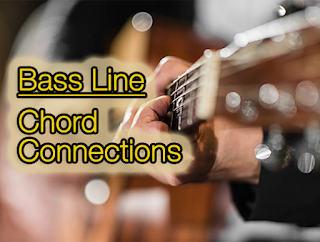Chord Changes & Bass Line Connections...
It's a big thrill to learn descending bass line chord progressions. Just getting the correct notes off of a song's recording can be a serious boost to your guitar playing confidence.
In this post, we'll take a look at how to create more interesting chord progressions built out of ascending and descending scale bass-line connections.
Some of the most simple bass line chord fills are best summed up by that wonderful cliché “the shortest distance between two points is a straight line.” For example, if you were playing a C chord in a song (in the key of C major), and the next chord in the song ended up being a G chord. Then, to connect those chords, all you would have to do is walk up (or down) the C major scale into the root of the G chord.
That type of philosophy is exactly the style we're going to apply in this lesson plan. Our goal will be in moving from one chord to another taking advantage of the scale from the key we're in for our bass line connection tones.
Take a run through example one to get a better idea of how this can work in a chord progression.
Example One:
Bass-line connection from "C Major" to "G Major."
You can hear how even a simple fill such as this idea can really do a lot for the progression. Whether you're working in a band, or you're working as a solo guitarist, these passing tone fills offer guitar players an enhanced sound around chord changes.
Now let's try expanding on this idea by learning a bass line connection going from a "C major" chord over to an "F Major" chord in the same key, (C Major).
Example Two:
Bass-line connection from "C Major" to "F Major."
With this understanding (covered in example 1 and 2), of how the chords of the I-IV-V operate on their own, we can now mix the chord changes and develop a bass line connection across more chords using this I-IV-V harmony.
In example three, the chords of "C, F and G" Major are combined into a chord progression that covers four measures and includes bass line connections for each transition.
Example Three:
Bass-line connection from "C Major" to "G Major," to "F Major."
Once this method is applied to the popular chord movements that we'll find between the most common "I-IV-V" chord changes, we can begin working on creating other bass line connections between chord changes in a harmony.
In example four, a movement of "I-VI-II-V" is occurring in the key of "G Major." I've composed a collection of bass line passing connections between each.
Example Four:
Key of "G major" chords of "G, Em, Am, D."
Click to enlarge image full-screen
CONCLUSION:
Now that you've had a chance to test these bass line chord connections in a few example progressions, it's time to go forward and develop the process across all types of chord movements found in the music that you enjoy playing.
When doing this "Bass Line Connection" process, keep your scale and your key signature in mind and test different scale tones for how they will best connect into each chord's root note. Work at developing smooth connections from one chord into the next. Get creative and invent ways that chord movements can appear dynamically.
Also keep in mind that bass line connections may occur in ascending or in descending ways. There is no set "rule" for how this sound should be applied in a piece. Do what you think sounds cool. If you enjoy the line, keep it. If not, try something else. Eventually you'll stumble upon that perfect connection.
___________________________________________________
GET GOOD NOW - JOIN THE MEMBERS AREA










